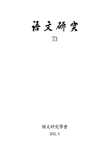학술논문
광고언어의 동음이표기(同音異表記)에 대하여
이용수 434
- 영문명
- A Study on the Homophones in the Advertising Written Language
- 발행기관
- 어문연구학회
- 저자명
- 김정태(Jeong-tae, Kim)
- 간행물 정보
- 『어문연구』語文硏究 第73輯, 61~86쪽, 전체 26쪽
- 주제분류
- 어문학 > 한국어와문학
- 파일형태
- 발행일자
- 2012.09.28
5,920원
구매일시로부터 72시간 이내에 다운로드 가능합니다.
이 학술논문 정보는 (주)교보문고와 각 발행기관 사이에 저작물 이용 계약이 체결된 것으로, 교보문고를 통해 제공되고 있습니다.

국문 초록
본고의 대상은 광고언어 중에서 광고문자언어를 동음(同音)의 다른 문자로 표기한 것이다. 이러한 동음이표기의원리는 생산자의 광고내용(상품, 프로그램 등)과 의미적으로 연계된 문자언어로 표기하여 그 의도를 극대화한 것이었다. 이와 같은 동음이표기는 최근광고의 한 경향을 이루고 있는 형태이다. 이를 테면, 생산자가 수용자의 관심을 끌어 구매를 유인하거나 참여를 독려하는 의도에서 비롯된 것으로 보았다. 이를 광고의 기능에 기대어 전자를 경제적 기능, 후자를 사회적 기능을 담당하는 것으로 보았는데, 특히 동음이표기 형태 광고에서는 드물게 양 기능을 복합적으로 담당하는 경우도 있었다.
이에 본고는 광고언어의 동음이표기 형태가 어떠한 특징을 보이고 있는가를 고찰하였다. 즉 생산자의 의도를 달성하기 위해 다양한 언어적 기법을 강구하였는바,‘고유어→한자, 고유어→로마자, 고유어→한글, 한자어→한글, 한자어→한자, 한자어→로마자, 영어→한글, 영어→한자, 영어→로마자, 혼합형’ 등으로 유형화하여 분석한 특징은 다음과 같다.
첫째, 광고문자언어 동음이표기는 전통적인 음차 표기 형식과 크게 다르지 않다.
둘째, 광고문자언어 동음이표기는 생산자의 의도성이 짙다. 그 의도는 일반적으로 수용자의 관심을 끌어 구매력을 높이거나 참여를 독려하는 것이었다. 이와 같은 생산자의 의도를 효율적으로 달성하기 위한 매체 형태도 다양하였다. 즉 간판, 현수막, 판촉물, 상품명 등에 이른다.
셋째, 동음이표기의 유형 중에서 고유어를 동음의 한자나 로마자로 표기한 경우가 적극적이다. 광고언어의 대부분이 우리말인 점에서 예측되는 특징이기도 하다.
넷째, 광고언어가 일반적으로 경제적, 사회적 기능을 하는 것으로 볼때, 동음이표기의 광고에서는 경제적 기능을 도모한 것이 더 생산적이었다.
다섯째, 동음이표기는 2000년대 초반 광고언어의 한 경향을 이루는데, 대체로 비문법적이고 비규 범적이다. 문법을 파괴함으로써 수용자의 관심을 끈 의도가 있는 것으로 볼 수 있다.
광고언어도 중요한 언어자원이다. 우리의 학문의 경향이 이론 중심이어서 광고언어와 같은 것을 도외시했던 것이 현실이다. 그렇지만 우리의 생활 속에 언어가 있고, 간판이나 현수막과 같은 실생활속의 형태도 언어에 의해 이루어지는 것이라면 이와 같은 광고언어도 중요한 것이다.
영문 초록
The homophones in the advertising written language were a subject of this study. The intent of advertisement can be maximized by using the homophones semantically related with the contents (products, programs, and so on) of advertisement. Using homophones in advertisement is now a trend. In other words, this kind of advertising technique appeared in order to induce the viewers of advertisement to purchase a product or participate in a program. The former is an economic function of advertisement, and the latter is a social function of advertisement. Especially, the advertisement using homophones uncommonly performs the two functions.
In this regard, this study aimed at considering the characteristics of the homophones in the advertising written language by categorizing the homophones into ‘native words->Sino-Korean words, native words->Roman characters, native words->Hanguel, Sino-Korean words ->Hanguel, Sino-Korean words->Chinese characters, English->Hanguel, English->Chinese characters, English->Roman characters, and mixed patterns’ and the results are as follows.
First, the way of using homophones in advertisement was not much different with that of using Eumcha.
Second, the homophones in advertisement are clearly made by producers in order to induce viewers to purchase or participate.
Third, in order to achieve the goals of products, various techniques are used. Therefore, there are lots of patterns.
Forth, most of the homophones are the cases of changing native words into Chinese characters or Roman characters. This is understandable because most of the advertising written languages are Korean.
Fifth, the homophones are more productive when they are used to promote an economic function, thinking of an economic function and a social function of the advertisement.
Sixth, various media are used in order to accomplish the intent of producers: signboards, banners, pamphlets, and product names.
Seventh, the homophone is a trend of the advertisement of the early 2000s.
Eighth, the homophones are generally used as nongrammatical. Breaking the rules of grammar makes people get interested.
The advertising written language is also an important language resource. It is true that the advertising written language was not studied much because theories were the main subject of our study. However, the advertising written language is critical because the language exists in our daily life, and things like signboards and banners are made of languages.
목차
<국문초록>
1. 서론
2. 동음이표기의 유형
3. 결론
Abstract
키워드
해당간행물 수록 논문
- 해방 이후 한국인 이름의 특성 및 변천 양상에 대한 사회언어학적 연구
- 한ㆍ중 초기 모더니즘 시론의 비교 연구
- 김소월 시의 언어미학적 특성 연구
- 미주 지역 한인의 국어교육 전개양상
- 雪峯 姜栢年의 漢詩 硏究
- 광고언어의 동음이표기(同音異表記)에 대하여
- 1910년대 초반 서사적 계몽성의 마지막 모습
- 유치환의 자연시 연구
- 학술논문 문형의 문법적 특징과 담화 기능에 대하여
- 추정과 비추정의 ‘-겠-’의 의미
- 정선방언 운율유형에 관한 연구
- 조선후기 通信使의 贐章 연구
- 일제강점기 3대 전래동화집의 성격과 그 편찬 배경
- 淸陰 金尙憲의 遊仙詩 小考
- 玉所 權燮의 演戱詩 考察
- 『독립신문』소재 『애국가』 의 텍스트 언어학적 특징
- 허균 문학 의식의 기원
참고문헌
관련논문
어문학 > 한국어와문학분야 BEST
- 국어의 줄임말 현상에 따른 언어변이 양상과 문제점
- ‘밈(meme)’을 활용한 고전문학과 문화콘텐츠의 상호 협력과 융복합교육
- 연구 동향 분석을 통해 본 학문 목적 한국어교육 연구의 실태와 제언
최근 이용한 논문
교보eBook 첫 방문을 환영 합니다!

신규가입 혜택 지급이 완료 되었습니다.
바로 사용 가능한 교보e캐시 1,000원 (유효기간 7일)
지금 바로 교보eBook의 다양한 콘텐츠를 이용해 보세요!






